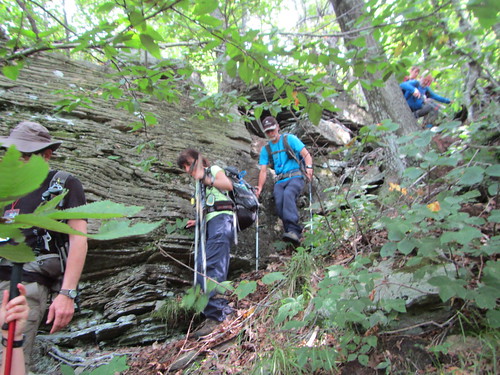Friday, September 25, 2015
Writing
Since I'm not doing capoeira, I have more free time on my hands, which gives me the kick in the pants I need to work on my writing. So, hooray? It occurred to me that with five year of practice, how much could I improve? Would I get "as good" as I was at capoeira? Better?
But that leads down a thorny philosophical and practical path ...
First, how do you compare the two realms? It's easy enough to say that Abby is as good at karate as Beth is at capoeira: They're both martial arts with some sort of ranking system. Maybe it's not 100% precise, but at a rough level it will do. You could maybe even say that Cassandra is as good at capoeira as Dionne is at chess. While they are very different sorts of activities, chess players, too, are ranked. But how does Evangeline's skill at tennis compare to Fabiola's at oil painting? Unless they're both utter novices, or at the very top of their field, where would you even begin?
Second, I estimate that I spend about 8 hours a week doing capoeira. I don't suddenly have eight free hours; some of that time has been replaced by doing workouts I have no particular commitment to. (I've gone to a few gymnastics classes; they make a great rebound relationship.) Should I spend 8 hours to make it equivalent? What about the writing I already do, or is counting composing an email as "writing" as desperate as counting "walking a block to the drugstore" as exercise?
Second.five, I am planning on doing NaNoWriMo this November. If I aim for the minimum 50,000 words, that's 1,667 words per day. At the rate I write, that's more than 2.5 hours per day, or almost 20 hours a week. That's assuming no days off, mind you. (I am hoping that exhaustive outlining will bring this number down.)
Third, I started capoeira with zero experience in any martial art, and I am not starting as a writer with zero experience, so after five years you would expect my writing skills to be higher than the equivalent of a green-yellow cord. (I'm still not sure how this writing ranking system would work. Is, like, Morrissey the lowest cord and a Pulitzer Prize-winner a mestre?)
Fourth, I need a better schedule. Group exercise works for me not because I'm an extrovert who just loves people! but because it makes me show up. I like the Shut Up and Write meetup for that reason, but I don't think that's a viable solution for seven days a week.
Well, no answers, except:
(1) I guess I can tell you in five years.
(2) Less time watching kittens on the internet would free that time right up.
(2.5) Although not that much time.
(3) I'd like to think I outrank Morrissey now.
(4) This is one way the irregular schedule of a professor is actually a problem.
Monday, September 14, 2015
Hiking in Westchester County

Westchester County, just north of New York City, isn't known as a hiking destination. It's a suburb, without any large parks within its borders. Of course, if one can find hiking within NYC, one can find hiking in Westchester. For the casual exerciser, there are plenty of parks and greenways to get out and jog or walk the dog. Putting together a lengthy hike is a bit more of a logistical challenge.
Luckily, the Ramblers thrive on those sorts of challenges, and this week's hike was 14.5 miles with probably only a mile on roads. We started from the Peekskill train statin and walked to Depew Park, which connects to the Blue Mountain Reservation. The reservation is mostly bicycle trails, but hiking is allowed. At the south end of the reserve we climbed up Spitzenberg Mountain, which would more accurately be called a hill. The photo at left is of one of our hikers approaching the summit. At the top there is an old building and a nice view of the Hudson River.
 We then followed the Peekskill Briarcliff Trailway to the New Croton Dam, which holds water for New York City and marks the beginning of both the Old and New Croton Aqueducts. The OCA* is no longer in use, but a trail following its path stretches all the way down into Van Cortlandt Park. We followed the trail as far as Ossining, where we caught a train back into the city.
We then followed the Peekskill Briarcliff Trailway to the New Croton Dam, which holds water for New York City and marks the beginning of both the Old and New Croton Aqueducts. The OCA* is no longer in use, but a trail following its path stretches all the way down into Van Cortlandt Park. We followed the trail as far as Ossining, where we caught a train back into the city.The hike was overall very nice in a "pretty woods" sort of way. Elevation changes were moderate. The dam was the highlight in the middle of the hike, but the woods to the north felt surprisingly isolated at times, although not wild - old stone walls and the occasional backyard served as reminders this was the suburbs.
* Everyone calls it the OCA for short, but I have trouble with that. To me, the OCA will always be the Oregon Citizens Alliance, the hate group that sponsored anti-gay Measure 9 when I was in high school. On the other hand, the "Old Croton Aqueduct trail" is a mouthful.
Saturday, September 12, 2015
Icelandic fashion
I blogged over at the LIM College faculty blog about Icelandic fashion.
Saturday, September 5, 2015
What I have learned from capoeira
I have stopped doing capoeira. Maybe forever, maybe for now, but I doubt I’ll ever be as serious about it again as I once was. In some ways the choice was hard.
That’s what 2015 has been about for me: Stripping things out of my life, to find out what’s left and what’s really me. Trying to find out what choices I’ll make with some of my assumptions gone. And capoeira was something that not only took up a lot of my time, it constrained my choices - for example, where to live.
A friend on Twitter posted something about taking the lessons from your past and moving on. Most wisdom is trite until it hits you when you need it, right?
So here is what I learned in five years of capoeira. Some of it I thought I already knew, but apparently I had to learn it again.
- My body can do more than I thought it could.
- Those with less natural talent are often better teachers than those abundant in natural talent.
- Portuguese.
- When people’s actions contradict their words, believe their actions.
- Most of your friends are friends of convenience. Whether its because you train together, work together, or are neighbors, when the mutual activity stops, the friendship does too. If you find someone who remains your friend, hold on to them.
- Hardly anyone uses every muscle in their body properly. If you’re active, it’ll catch up with you by your 30s, when it’s still easier to fix it. If you’re inactive, it’ll catch up with you when you’re elderly.
- Capoeira has a huge problem with male teachers preying on female students. I’ve seen all of the following:
- A male teacher engaged to a female teacher, who hits on another capoerista.
- A male teacher living with a female student, who hits on another student, offering to move to be with her.
- A male teacher sleeping with several of his female students, not serially.
- A male teacher in a supposedly monogamous relationship with a female student, but also being in another second, also supposedly monogamous relationship with:
- Another female student at a different school.
- Another female student in the same school.
- A male teacher who regularly cheats on his girlfriends with a female capoerista (not his student).
- A male teacher sexually propositioning students who have shown no interest.
- A married male teacher making out with a female capoerista.
- You need to be honest with yourself about why you’re involved with something. If you deny it to yourself, you’ll end up frustrated because you’ll likely pick a group that gives you what you claim to want instead of what you really want.
- Never date someone who thinks they deserve to be excepted from what even they agree is ethically correct. Don’t even be friends with that kind of person.
- Even someone totally untalented at music, like myself, can improve.
- Never look down on the person whose priorities change today, for tomorrow that could be you.
- People may choose to forgive people who have hurt them, but it’s never your business to tell them they must.
- People rarely share scuttlebutt with those who most need to know it.
- If you’re bothered by the way people are treating you, make sure you’re not treating other people in that same way.
- People at the top set the tone. If the leader makes Mistake X, so will the followers. If the leader doesn’t do Mistake Y themselves but doesn’t make stopping it a priority, some of the followers will Y.
- If someone seems unhappy, see if they want to talk, even if you aren’t close. If they don’t, of course, don’t push it, but far too often no one at all is willing to get involved.
- Breathing and not looking at the floor really help when doing cartwheels.
- I have no problem eliminating people and things from my life when they offer me nothing. I have a lot of difficulty eliminating people and things when they are just okay but standing in the way of truly good.
- As Thich Nhat Hahn said, there is no such thing as a perfect sangha; one must simply strive to be the best member of the sangha one is in.
- Fresh papaya is really delicious.
Thursday, September 3, 2015
The Sausagefest of Shannara
I'm a bad fantasy reader - my sword-and-sorcery reading is actually fairly limited. Most epic fantasy doesn't interest me much. But then I found a copy of The Sword of Shannara for $1 at Shandaken Days, sold by the steampunk proprietors of Pine Hill's only bookshop, so I figured it was time to finally read some Terry Brooks.
No suspense here: I strongly disliked it. But literary merit aside, what was most striking to me was the lack of female characters. Consider:
There are 55 male characters and nine female characters, a few genderless creatures, and many (minor) characters unidentified by gender. Of those nine women, one is present but an illusion, one is probably fictional, five are only discussed or remembered by the men, and two are both present in the scene and real. One of the two real, present women is an old serving woman who appears and is gone in one paragraph. The other only appears halfway through the book, on page 430.
Shirl's character is pretty limp, and she seems to have no agency whatsoever. She is uninterested in the advances of the man who is obsessed with her, although she is nevertheless probably going to marry him. She is kidnapped and then rescued. She falls in love with her rescuer. Most of her action and dialog consists of waiting, listening to him talk about himself, and telling him to take care of himself.
One telling detail is that Brooks was the kind of writer who used "man" to mean "human." While this is old-fashioned, he really seems to mean it. All the women are either mothers or love interests (or a serving woman). There aren't even serving wenches in the inns or alive mothers to send their sons off.
Of course, Brooks is hardly alone in this. To be fair, compare Sword to J.R.R. Tolkien's The Hobbit, a book I like much better:
The Hobbit actually comes off worse, as there are no women actually present in any scene. (The paltry few women in his trilogy suddenly seem overwhelming in number. Of course, it's rather like comparing the healthy food choices at fast food restaurants: "Hey, this place actually has a withered salad with carrot scrapings and a sad tomato!") To the extent that Brooks is a pale imitation of Tolkien, his lack of women is at least authentic.
I can enjoy books in spite of these kinds of issues (as I said, I liked The Hobbit), but some days they're just too hard to ignore.
No suspense here: I strongly disliked it. But literary merit aside, what was most striking to me was the lack of female characters. Consider:
There are 55 male characters and nine female characters, a few genderless creatures, and many (minor) characters unidentified by gender. Of those nine women, one is present but an illusion, one is probably fictional, five are only discussed or remembered by the men, and two are both present in the scene and real. One of the two real, present women is an old serving woman who appears and is gone in one paragraph. The other only appears halfway through the book, on page 430.
Shirl's character is pretty limp, and she seems to have no agency whatsoever. She is uninterested in the advances of the man who is obsessed with her, although she is nevertheless probably going to marry him. She is kidnapped and then rescued. She falls in love with her rescuer. Most of her action and dialog consists of waiting, listening to him talk about himself, and telling him to take care of himself.
One telling detail is that Brooks was the kind of writer who used "man" to mean "human." While this is old-fashioned, he really seems to mean it. All the women are either mothers or love interests (or a serving woman). There aren't even serving wenches in the inns or alive mothers to send their sons off.
Of course, Brooks is hardly alone in this. To be fair, compare Sword to J.R.R. Tolkien's The Hobbit, a book I like much better:
The Hobbit actually comes off worse, as there are no women actually present in any scene. (The paltry few women in his trilogy suddenly seem overwhelming in number. Of course, it's rather like comparing the healthy food choices at fast food restaurants: "Hey, this place actually has a withered salad with carrot scrapings and a sad tomato!") To the extent that Brooks is a pale imitation of Tolkien, his lack of women is at least authentic.
I can enjoy books in spite of these kinds of issues (as I said, I liked The Hobbit), but some days they're just too hard to ignore.
Tuesday, September 1, 2015
Hiking North Dome and Sherrill

On Sunday, I finished two more trailless Catskills peaks with the Catskills 3500 Club. North Dome and Sherrill are neighbors, just west of the Devil's Path. We first climbed up to North Dome, then down and back up to Sherrill. As with all the trailless peaks, the entire hike was quite steep.
This photo is from the descent from North Dome. There was a fair amount of interesting rock, not too much face-slapping balsam, and less stinging nettle than I expected. Neither peak offers a view at the top, alas.
However, near the end of our hike we were rewarded with this waterfall:

Subscribe to:
Comments (Atom)

